|
|
|
On the 9th of April 1979, Australia Post issued a series of seven stamps commemorating the National Parks of Australia. One of these stamps features Bald Rock Creek in Girraween National Park.
The stamp series portrays national parks chosen from each of the six states and the Northern Territory. It was issued to coincide with the centenary (1879) of the Royal National Park near Sydney, NSW. The Royal National Park has the distinction of being the first reserve the world to be officially named a "national park" and is the world's second oldest national park - after Yellowstone in the USA.
At the time of the stamps' issue, there were approximately 12 million hectares of land reserved as national parks or for equivalent conservation purposes in Australia. In 2012, the National Reserve System includes more than 9,400 protected areas covering nearly 14% of the country - almost 106 million hectares.
|
|
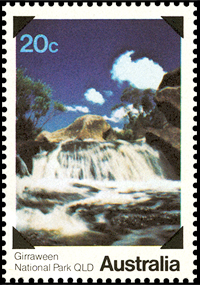
|
Stamps shown larger than actual size.
Text reproduced from the 1979 Stamp Bulletin with permission by Australia Post.
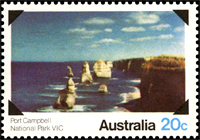
|
|
Port Campbell National Park
Two hundred and eighty-five km south west of Melbourne, Victoria, via the Great Ocean Road, lies a strip of rugged coastline where the sea has created many unusual sculputres from the soft limestone cliffs. This is Port Campbell National Park and the indented coastline contains a strange gallery of gorges, arches, islands and blowholes. The Park features Mutton Bird Island (home of the remarkable Mutton Bird which migrates 24,000 km each year), the Fairy Penguin rookery (the only penguin native to the Australian mainland) and numerous shipwrecks (including the 'Loch Ard' Clipper, shipwrecked in 1878 with the loss of 50 lives). Port Campbell National Park derives its name from Captain Alexander Campbell, a Scotsman who was in charge of the now defunct Port Fairy whaling station. The scene on the stamp shows the 'Twelve Apostles', twelve rock stacks which have been isolated from the coast by the sea.
|
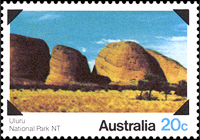
|
|
Uluru National Park (Uluru-Kata Tjuta National Park)
In 1872 Ernest Giles sighted the Olgas (now in Uluru National Park, Northern Territory) and named the highest dome Mt Olga, after the Queen of Spain. Mt Olga rises 546 metres above the surrounding plains and forms part of the 36 domes known as the Olgas. The red sandstone which comprises this incredible conglomeragion was deposited 500 to 600 million years ago. These mountainous formations are actually summits of buried sandstone hills, and like protruding icebergs, are merely the tips of great masses of rock beneath the surface. The Olgas cover 35 square kilometres and are 32 kilometres west of Ayers Rock, the other prominent feature of Uluru National Park. Many aboriginal tribes have featured Uluru (meaning 'the Rock') in their ritual life and dreamtime stories and the caves at the base of the Rock are also famous for their aboriginal art. The Park area is 126,132 hectares [in 2012 this is 132,500 hectares] and the Olgas are featured on the stamp.
|
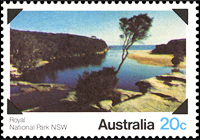
|
|
Royal National Park
Royal National Park is situated on the coast, 32 kilomtres south of Sydney and was Australia's first, and probably the world's second, National Park. It was named 'National Park' in 1886 and proclaimed Royal National Park in 1955, following Queen Elizabeth II's visit to the area in 1954. Royal National Park is also well known for the region's abundant flora and fauna. The Park is host to more than 700 species of native trees and plants, and approximately 250 species of birds, as well as many marsupials, reside within its boundaries. The Park's magnificent Pacific coastline contains 25 kilometres of surfing beaches and rugged unspoilt cliffs, and as well as being popular with visitors these are important natural features. The stamp features Wattamolla Lagoon looking east to the Pacific Ocean.
|
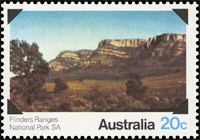
|
|
Flinders Ranges National Park
Flinders Ranges National Park covers over 78,000 hectares of the spectacular Central Flinders Ranges [in 2012 it is now 91,200 hectares] and was vested a National Park in 1972. This extensive mountain chain stretches over 430 kilometres and is north of Port Pirie, in South Australia. The Park area was once occupied by three aboriginal tribal groups, the descendants of which still exist as the Adnyamathanha tribe (adnj - hills; manthana - people). Wilpena Pound, of special attraction to Park tourists, is a natural amphitheatre surrounded by rugged ridges rich in aboriginal rock carvings. The Pound is deeply involved in complex aboriginal myths which embrace many parts of the Flinders Ranges. E J Eyre named the Flinders Ranges after the navigator Matthew Flinders and the stamp features Arkaroo Rock and Pound Wall.
|
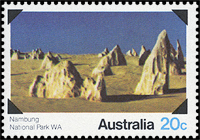
|
|
Nambung National Park
Approximately 180 kilometres north of Perth, Western Australia, is Nambung National Park. This Park, containing 17,332 hectares [17,491 hectares in 2012] of land was vested in 1968 and takes its name from the aboriginal word 'Nambung', meaning a place of water. The main attraction at Nambung National Park is the Pinnacles, a collection of limestone columns standing in a red sand desert. A few columns are solid limestone, but most contain an assortment of calcified root systems of trees and plants which grew in the area thousands of years ago. Another feature of the Park is the brilliant white sand dunes, often called the White Desert. The stamp features the Pinnacles.
|
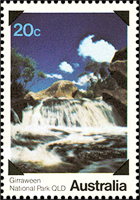
|
|
Girraween National Park
Outcrops of cooled magma (a type of granite) are one of the most interesting features of Girraween National Park in Queensland. The first white man to visit the area, explorer Allan Cunningham, described these in his journal of 1828 as 'large detached masses of granite of every shape towering above each other and in many instances standing in almost tottering positions'. In addition to these outcrops, the wide variety of vegetation, flowering plants and native species makes Girraween 'the place of flowers' as its aboriginal name translates. Wildflowers thrive in the sandy soil and many of the plants in the Park have a limited distribution in Queensland. The stamp features Bald Rock Creek, which flows through the Park and is popular with swimmers. Girraween National Park is situated off the New England Highway approximately 260 km south of Brisbane.
|
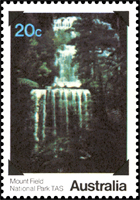
|
|
Mount Field National Park
Mount Field National Park encompasses 18,600 hectares of land and is situated 60 kilometres west of Hobart, Tasmania. [In 2012, Mount Field National Park is 15,881 ha. The 18,600 hectares mentioned in the "Stamp Bulletin" may have also included some smaller surrounding reserves, which are not actually part of the park.] The Park, which was vested in 1916, is a high plateau with glacial valleys and cirques (natural amphitheatres). The highest peaks, Mt Field West (1442 metres) and Mt Field East (1270 metres) are accompanied by numerous alpine lakes, including Lake Dobson (1051 metres) and Lake Fenton (1006 metres). The Park also boasts streams babbling through lush fern-gullies with dense undergrowth shaded by giant Mountain Ash. Russell Falls, which is featured on the stamp is a series of cascades which fall 65 metres in two sheer drops to land in a shady gorge.
|
- Designer: Max Robinson/PROSPA, Melbourne
- Printer: Asher & Co, a division of Leigh Mardon Pty Ltd, Melbourne
- Printing Process: Photo-litho (4-colour Roland Ultra)
- Paper: Litho chromo stamp paper incorporating helecon
- Perforation: 15½, comb
- Size (including perforations): 37.5mm x 26mm
The series consists of two se-tenant strips of 20 cent stamps. One strip contains five horizontal se-tenant stamps and the other has two vertical se-tenant stamps. It was printed in sheets of 300 and issued in sheets of 100.
Sales period was approximately six weeks at post offices and until 9th April 1980 at philatelic sales centres (while stocks lasted).
Thank you to Richard Breckon from the Australia Post Philatelic Archives for providing us with so much information and all the images of the stamps and related products.
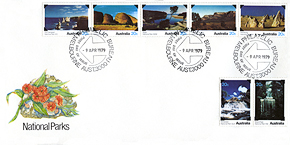
First Day Cover
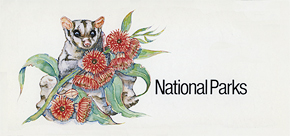
Stamp Pack cover
|
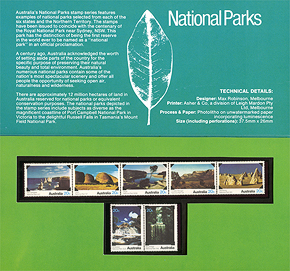
Stamp Pack interior
|
|
|

